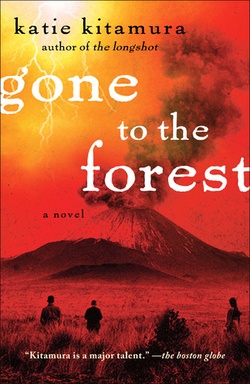Three years after the release of her first novel, The Longshot, Katie Kitamura is drawing praise once again for her second novel, Gone to the Forest. Although a relatively new name in the literary world, the author has garnered acclaim from an eclectic group of reviewers. Both of her books were finalists for the New York Public Library’s Young Lions Fiction Award.
Salman Rushdie writes of the writer’s latest work:
“One thinks at times of both Coetzee and Gordimer, but Kitamura is very much her own writer, and makes you feel keenly the tragedy of her three lost souls.”
Evie Wyld, author of After the Fire a Still Small Voice, comments:
“I have been in a daze ever since I finished this book. Gone to the Forest is superb. It is so beautifully written, so balanced—there isn’t a spare sentence or word in the whole thing. Utterly distinctive, it is almost allegorical in its force. Kitamura is one of the best living writers I’ve read, and she gives the dead ones a run for their money.”
These are enviable reviews for Katie Kitamura, who, in a recent interview, revealed that she has had no formal training as a writer. “I did most of my learning by reading. In many ways, I think that’s the best training for a writer, to develop your taste and skills as a reader.”
According to the author, the initial concept for this novel’s plot began “with an image—a river of fish, coated in volcanic ash—and worked outward from there. Often a novel will begin with an image that hooks into my brain that I keep returning to. The process of writing is finding the narrative that makes sense of that image.”
Part of the creative beauty of Gone to the Forest lies in its ambiguity and the author’s spare style. There is great power in what Kitamura leaves unsaid. The novel is set in an unnamed colonial country. On the 100,000 acres of land originally claimed by his father forty years earlier, Tom struggles to manage the family farm in the midst of civil unrest that has driven away many white landowners. The relationship between father and son is distant, both men haunted by the premature death of Tom’s mother. Nothing, however, brings about more anguish to Tom’s relationship with his father than the arrival of Carine, the young woman with a “questionable reputation,” who has been chosen to be Tom’s future wife.
The novel’s fictional setting is at once real and yet indeterminate. In regard to creating this setting, Katie Kitamura explained, “I wanted to create a setting that was a composite of multiple colonial settings. In the novel, there are elements of Zimbabwe, Kenya, Argentina, India—the idea was to create a collage of colonialism, one that would carry deliberate inconsistencies and elements that jarred. I was interested in the role of these colonial narratives in the cultural imagination, so part of the research was reading the novels, seeing the films, looking at the images, they generated over the years.” Thrust into a setting of civil and familial turmoil, Tom and his father are tested by physical violence, a natural disaster, and a love triangle. Both men struggle for control in a world fraught with elements that are ultimately beyond their control.
As an Asian American writer, Katie Kitamura acknowledges the support she has received through organizations like the Asian American Writers’ Workshop, which supported the publication of both of her books.
On Saturday, August 31, 2013 at 2:00 pm, Ms. Kitamura will discuss Gone to the Forest at the Japanese American National Museum as part of the Museum’s Books & Conversations Series.
© 2013 Leslie Yamaguchi






